- Welcome
- Use case
- Getting Started
-
Searching Records
- Performing a Basic Search
- Performing an Advanced Search
- Performing a List Search
- Performing a Keyword Search of UUMC Pathology Reports for all Patients in the Database
- Performing a Keyword Search of UUMC Pathology Reports for the Patients Associated with a Specific Set of Specimens
- Restrictions on Searches
- Reports
-
iQ Tool
- Adding Columns to a Query
- Starting the iQ Tool
- iQ Tool Window
- Current Query Data Group
- Saved Queries List
- Top Portion of the Selected
- Display or Report Columns Section
- Find/Filters Section
- Running a Preexisting Query
- Creating a Query
- Create Query Window
- Copying and Altering a Preexisting Query
- Removing Columns from a Query
- Editing Column Parameters in a Query
- Changing the Order of Columns in a Query
- Adding Filters to a Query
- Editing Filters in a Query
- Ways of Comparing Data
- Removing Filters From a Query
- Results Window
- Application Data Structure
- Application Database Fields Alphabetical List
- Application Datatree
- Field Paths List for the iQ Tool
-
Adding Specimens to the Database
- Adding a Single Specimen using the Add Specimen Wizard
- Adding a Batch of Specimens using the Add Specimen Expert Tool
- Saving a Batch of Specimens to be added as a Work in Progress
- Finishing a Work in Progress Batch
- Printing Barcodes for a Specimens in a Batch added using the Add Specimen Expert Tool
- Customizing the Add Specimen Expert Tool to Streamline Specimen Batch Entry
- Changing which Box an Add Expert Template Points for Adding Storage
- Importing FFPE Samples from UUMC
- Entering and Editing Specimen Records
- Transformations
- Specimen Disbursement and Registration
- Reports and Records
- Adding a Pathology Report to a Specimen Record
- Performing a DEXT Import of a Pathology Import
- Checking on the status of your DEXT Import Request
- Adding a Medical Record to a Specimen Record
- Editing Patient or Collection Records
- Editing Collection Records
- Editing Patient Records
- Diagnoses
- Adding a Diagnosis to a Patient Record
- Linking an Existing Diagnosis to one or more Collections
- Linking a Collection to a Diagnosis
- Recording a Consent for a Patient
- Reviewing a Patient's Consents
- Uploading a Patient's Consent Form
- Managing Patient Consents
- External (to itBioPath) Data Sources
- Managing Dictionaries
-
Storage
- Editing Aliquots
- Connecting a Barcode Label Printer to itBioPath
- Removing a Barcode Label Printer from itBioPath
- Freezer Management
- Viewing the Contents of a Box in a Freezer
- Accessing the Specimen Record for the Specimen associated with an Aliquot
- Editing Box Details
- Adding a New Box to a Freezer from the Add Aliquot Window
- Managing Protocols, Projects, and Related User Permissions
- Window, Tab, and Field Descriptions
- Miscellaneous
The process of transforming a specimen does more than simply copy basic information from the parent specimen to a new specimen record. It maintains a history of the relationship between various specimens in the database so that any user viewing a specimen record can tell how that specimen relates to other specimens in the database from the same collection — see Managing Specimen Transformations. Accordingly, in the process of recording the transformation, some information from the parent specimen will be copied as a default value to the child specimen. However, the user will have the opportunity to change this default information and add additional information that is unique to the child specimen upon adding the new child specimen to the database. Transformations are different than duplicating an existing specimen. It is recommended that you use the transformation process to record these actions, rather than simply duplicating the parent specimen, whenever a transformation has occurred. The actual decision about what constitutes a transformation and when to record a transformation will be guided by agreed-upon department processes and principles established by HCI's data management committee. To create a specimen record for a transformed specimen:
- Open the specimen record for the specimen that is the parent of the new transformed specimen (the specimen the new specimen was transformed from).
- Select the Related Specimens tab.
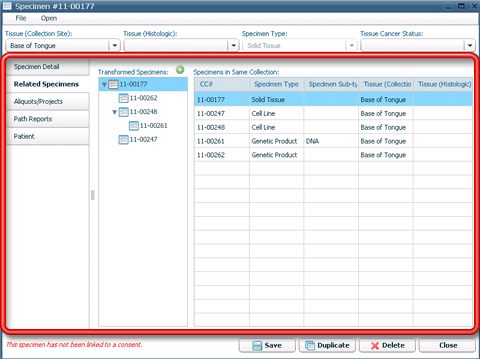
- Click on the
 button above the Transformed Specimens list. The Transform Specimen window will open.
button above the Transformed Specimens list. The Transform Specimen window will open.
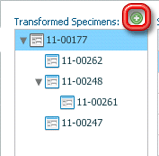
- Fill in the appropriate information about the newly transformed specimen on Step 1 of the Transform Specimen wizard.
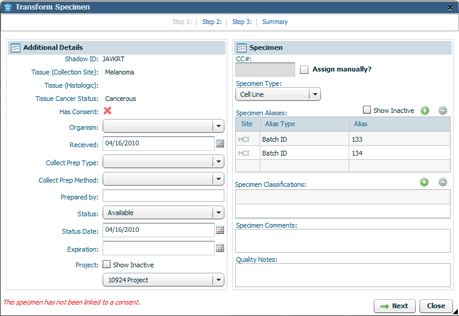
- Click the Next button in the lower right corner of the window. The window will switch to Step 2 of the Transform Specimen wizard.
- Select the appropriate aliquot from among the available aliquots for the specimen listed in the grid on Step 2. If the entire aliquot is not to be transformed, select the amount of the aliquot that will be used in the transformation.
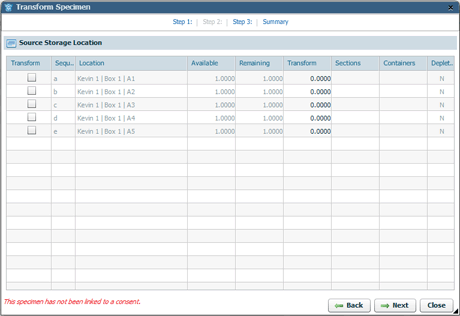
- Click the Next button in the lower right corner of the window. The window will switch to Step 3 of the Transform Specimen wizard.
- Fill in the appropriate storage information (where the aliquots for the newly transformed specimen will be stored) on Step 3 of the Transform Specimen wizard. To add an aliquot, click on the
 button above the upper right corner of the aliquots list and record the appropriate information on the window that appears. See Adding Aliquots for instructions related to recording aliquot information.
button above the upper right corner of the aliquots list and record the appropriate information on the window that appears. See Adding Aliquots for instructions related to recording aliquot information.
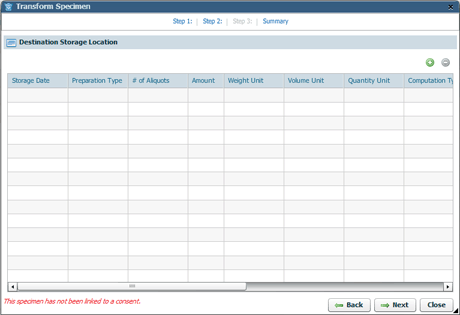
- Click the Next button in the lower right corner of the window. The window will switch to the Summary page of the Transform Specimen wizard.
- Review the information on the Summary page to make sure that the information you have entered is correct.
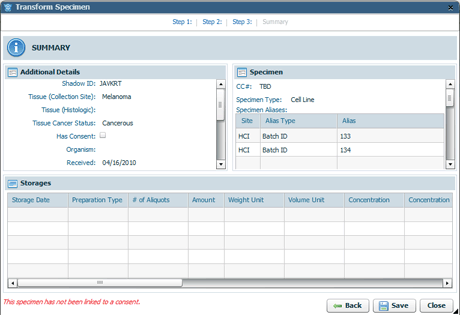
- Click
 in the lower right corner of the window. The window will close and the new (transformed) specimen will appear in the Transformed Specimens list of the parent specimen's window (represented by its newly assigned CC#).
in the lower right corner of the window. The window will close and the new (transformed) specimen will appear in the Transformed Specimens list of the parent specimen's window (represented by its newly assigned CC#).




